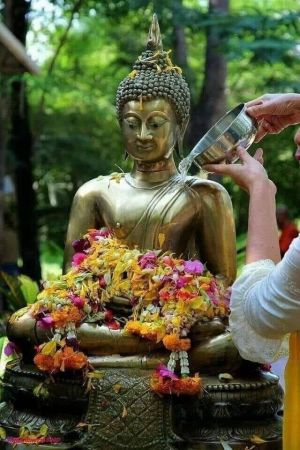Ceremonies of Ordination
There are a number of different ceremonies in the Japanese and Jodo Shu tradition for followers to become devotees as well as formal priests or nuns. In Buddhism, one is not forced to take part in these ceremonies to be considered a follower. The ceremonies for becoming a priest or nun, however, are mandatory for receiving that status. The ceremonies for lay followers are optional and are generally taken by those with sincere and earnest commitment.
Taking Refuge in the Triple Gem (kikyo-shiki)
This is a common ceremony in all of Buddhism in which a follower first enters the Buddhist path by taking refuge in the Buddha, his teachings (the Dharma), and the community of followers (the Sangha). This ceremony marks a person's initial entrance into Jodo Shu.
This is the ceremony of taking of the five basic Buddhist precepts (kairitsu) [no killing, lying, inappropriate sexual conduct, stealing, or intoxication]. In Jodo Shu, these precepts are seen as Miscellaneous Practices (zogyo) in support of the Rightly Established Practice (shojo no go), the chanting of the nembutsu.
The Fivefold Transmission Retreat (goju-soden-e)
This is an important training activity for Jodo Shu lay followers. It is regarded as advanced training for Jodo Shu followers. The fivefold transmission refers to the five aspects of Jodo Shu practice:
1) understanding oneself as an ordinary, defiled person (bonpu);
2) the [[practice of the [nembutsu]];
3) understanding the teachings;
4) seeing the proof of the results of the practice; and
5) gaining faith in the practice.
The Ordination Ceremony (tokudo-shiki)
This is the formal ordination ceremony that a follower takes in becoming a priest or nun. It only takes place after several years of intensive study by the follower. At this time, the follower receives tonsure (teido), the ceremonial shaving of his/her hair. The follower also receives a dharma name (kaimyo). A dharma name generally symbolizes a person's entry into the Buddhist path. It is usually conferred on three different occasions marking three different stages in a follower's spiritual maturation.
a) Taking the Precepts - a dharma name may be given to a lay follower upon taking the lay precepts at the jukai-e.
b) Ordination - when a follower ordains as a priest or nun a dharma name is given.
c) Death - a dharma name is given at the time of death symbolizing the deceased's final entry into the Buddhist path and his/her Birth in the Pure Land.
Source
[[1]]
